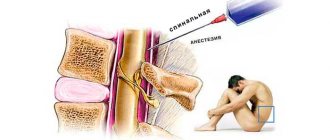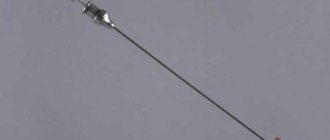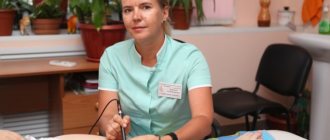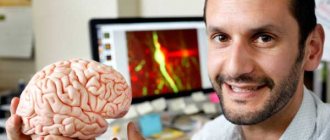Action potential or nerve impulse, a specific response that occurs in the form of an excitatory wave and flows along the entire nerve pathway. This reaction is a response to a stimulus. The main task is to transmit data from the receptor to the nervous system, and after that it directs this information to the desired muscles, glands and tissues. After the passage of the pulse, the surface part of the membrane becomes negatively charged, while its inner part remains positive. Thus, a nerve impulse is a sequentially transmitted electrical change.
The exciting effect and its distribution are subject to physico-chemical nature. The energy for this process is generated directly in the nerve itself. This happens due to the fact that the passage of an impulse leads to the formation of heat. Once it has passed, the attenuation or reference state begins. In which only a fraction of a second the nerve cannot conduct a stimulus. The speed at which the pulse can be delivered ranges from 3 m/s to 120 m/s.
Indications for use
These include:
- diagnosis of sleep disorders (insomnia, sleepwalking, sleep apnea) - electroencephalography detects changes in brain activity when falling asleep;
- diagnosis and selection of treatment for epilepsy - using EEG, you can assess the degree of disruption of brain function and monitor the effectiveness of medications;
- finding out the causes of seizures, panic attacks, fainting, frequent headaches;
- clarification of data from computed tomography, magnetic resonance imaging and some other examinations, if during these examinations there was a suspicion of the presence of a tumor and vascular disorders in the brain;
- condition after a stroke or head injury - to assess brain dysfunction;
- delayed speech development, stuttering.
Active properties of the membrane[ | ]
Diagram of the structure of a cell membrane.
The active properties of the membrane, which ensure the occurrence of an action potential, are based mainly on the behavior of voltage-gated sodium (Na+-) and potassium (K+-) channels. The initial phase of AP is formed by the incoming sodium current, later potassium channels open and the outgoing K+ current returns the membrane potential to the initial level. The initial ion concentration is then restored by the sodium-potassium pump.
During the AP, channels move from state to state: Na+ channels have three main states - closed, open and inactivated (in reality the matter is more complicated, but these three are enough for description), K+ channels have two - closed and open.
The behavior of the channels involved in the formation of PD is described in terms of conductivity and calculated in terms of transfer coefficients.
Transfer coefficients were derived by Hodgkin and Huxley.[1][2]
Conductivity for potassium GK per unit area [S/cm²]
GK = GK maxn 4 {\displaystyle G_{K}=G_{Kmax}n^{4}}
| dn / dt = α n ( 1 − n ) − β nn {\displaystyle dn/dt=\alpha _{n}(1-n)-\beta _{n}n} , |
| Where: |
| α n {\displaystyle \alpha _{n}} — transfer coefficient from closed to open state for K+ channels [1/s]; |
| β n {\displaystyle \beta _{n}} — transfer coefficient from open to closed state for K+ channels [1/s]; |
| n {\displaystyle n} is the proportion of K+ channels in the open state; |
| ( 1 − n ) {\displaystyle (1-n)} — the proportion of K+ channels in the closed state |
The conductivity for sodium GNa per unit area [S/cm²]
is more difficult to calculate, since, as already mentioned, voltage-dependent Na+ channels, in addition to the closed/open states, the transition between which is described by the parameter m {\displaystyle m} , also have inactivated/non-inactivated states, the transition between which is described through the parameter h {\displaystyle h}
GN a = GN a ( max ) m 3 h {\displaystyle G_{Na}=G_{Na(max)}m^{3} h}
| dm / dt = α m ( 1 − m ) − β mm {\displaystyle dm/dt=\alpha _{m}(1-m)-\beta _{m}m} , | dh / dt = α h ( 1 − h ) − β hh {\displaystyle dh/dt=\alpha _{h}(1-h)-\beta _{h}h} , |
| Where: | Where: |
| α m {\displaystyle \alpha _{m}} is the transfer coefficient from the closed to the open state for Na+ channels [1/s]; | α h {\displaystyle \alpha _{h}} is the transfer coefficient from the inactivated to the non-inactivated state for Na+ channels [1/s]; |
| β m {\displaystyle \beta _{m}} — transfer coefficient from open to closed state for Na+ channels [1/s]; | β h {\displaystyle \beta _{h}} is the transfer coefficient from the non-inactivated to the inactivated state for Na+ channels [1/s]; |
| m {\displaystyle m} is the fraction of Na+ channels in the open state; | h {\displaystyle h} is the proportion of Na+ channels in the non-inactivated state; |
| ( 1 − m ) {\displaystyle (1-m)} — fraction of Na+ channels in the closed state | ( 1 − h ) {\displaystyle (1-h)} is the proportion of Na+ channels in the inactivated state. |
Progress of the procedure
To record an electroencephalogram, about 20 electrodes are attached to a person’s head using an elastic helmet. Through an amplifier they are connected to a device - an encephalograph, which is usually combined with a computer.
The patient should sit relaxed and close his eyes, or lie with his eyes closed on the couch.
Article on the topic
Living supercomputer. Why does the brain need water and why is it more active at night? Often, when recording an electroencephalogram, doctors use so-called functional tests. These include intermittent light exposure, intense deep breathing for 2–3 minutes, and sound irritation. In some cases, an EEG is performed against the background of a pronounced load on the brain, for example after a sleepless night.
The examination usually lasts from 15 to 20 minutes. As a rule, there is no discomfort during it. Results are most often released on the day of the test.
Is a nerve impulse an electrical impulse or not?
Is a nerve impulse an electrical impulse or not?
There are different points of view: chemical and electrical. Googling results.
Dmitriy. Why are nerves not wires, and why is a nerve impulse not a current? (4.09.2013)
https://e-1-off.livejournal.com/8384.html
PHYSICAL ENCYCLOPEDIA:
NERVE IMPULSE is a wave of excitation that spreads along the nerve fiber and serves to transmit information from the peripheral. receptor (sensitive) endings to the nerve centers, inside the center. nervous system and from it to the executive apparatus - muscles and glands. Passage of N. and. accompanied by transitional electrical processes that can be recorded with both extracellular and intracellular electrodes... Along the nerve fiber, the nerve impulse spreads in the form of an electrical wave. potential. At the synapse, the propagation mechanism changes. When N. and. reaches presynaptic. endings, in synaptic. the gap releases an active chemical. substance - me d i a t o r. The transmitter diffuses through the synaptic. gap and changes the permeability of postsynaptic. membrane, as a result of which a potential arises on it, again generating a propagating impulse. This is how chem works. synapse. There is also electric. synapse when next the neuron is excited electrically...The state of rest of the nerve fiber...stationary due to the action of ion pumps
, and the membrane potential under open-circuit conditions is determined from the equality to zero of the total
electric.
current... The process of nervous excitation develops as follows (see also
Biophysics).
If you pass a weak current pulse through the axon, leading to depolarization of the membrane, then after removing the external.
impact, the potential monotonically returns to its original level. Under these conditions, the axon behaves as a passive electrical current.
circuit consisting of a capacitor and DC. resistance. If
the current pulse
exceeds a certain threshold value, the potential continues to change even after the disturbance is turned off...
The nerve fiber membrane is a nonlinear ionic conductor
, the properties of which significantly depend on the electrical fields.
https://dic.academic.ru/dic.nsf/enc_physics/4035/%…
ION PUMPS molecular structures built into biol. membranes that transport ions
towards higher electrochemical potential
SEMENOV S.N. ABOUT THE PHONON NATURE OF THE NERVE IMPULSE FROM THE POSITION OF THE DYNAMICS OF EVOLUTION
. (05/29/2013) Semyonov S.N. Phonon is a quantum of a biological (cellular) membrane.
https://vbibl.ru/fizika/69645/index.html Introduction to quantum phonon biology
S. N. Semenov
https://www.studsell.com/view/193942/
MOLECULAR-MECHANICAL MODEL OF THE STRUCTURE AND FUNCTIONING OF BIOLOGICAL MEMBRANES
INTRODUCTION TO QUANTUM PHONON BIOLOGY OF MEMBRANES. © S.N.
Semenov , Date of publication: September 8, 2003 Contact with the author
https://www.sciteclibrary.ru/rus/catalog/pages/6013…
Nikolaev L.A. “Metals in living organisms” - Moscow: Education, 1986 - p.127
In a popular science form, the author talks about the role of metals in biochemical processes occurring in living organisms. The book will help broaden the horizons of students. Both ions (sodium and potassium) take part in the propagation of electrical impulses along the nerve.
https://chemlib.ru/books/item/f00/s00/z0000000/st01…
The electrical nature of nerve impulses and the excitability of a nerve cell. Even on the eve of the 19th century, Galvani experimentally proved that there is a certain connection between electricity and the functioning of muscles and nerves. The establishment of the electrical nature of skeletal muscle excitation led to the practical application of this property in medicine. The Dutch physiologist Willern Einthoven contributed greatly to this. In 1903, he created a particularly sensitive galvanometer, so sensitive that it could be used to record changes in the electrical potential of the contracting heart muscle. Over the next three years, Einthoven recorded changes in the potential of the heart during its contraction (this recording is called an electrocardiogram) and compared the features of peaks and valleys with various types of cardiac pathologies. The electrical nature of the nerve impulse was more difficult to detect; at first it was believed that the emergence of an electric current and its spread along the nerve fiber was caused by chemical changes in the nerve cell. The reason for such a purely speculative judgment was the results of experiments by the 19th century German physiologist Emile Du Bois-Raymond, who, using a highly sensitive galvanometer, was able to register a weak electric current in a nerve when it was stimulated. As technology developed, studies of the electrical nature of the nerve impulse became more and more elegant. By placing tiny electrodes (microelectrodes) on various parts of the nerve fiber, researchers using an oscilloscope learned to record not only the magnitude of the electrical potential that arises when the nerve is excited, but also its duration, propagation speed and other electrophysiological parameters. For their work in this area, American physiologists Joseph Erlanger and Herbert Spencer Hesser were awarded the Nobel Prize in Medicine and Physiology in 1944. If electrical impulses of increasing strength are applied to a nerve cell, then initially, until the strength of the impulse reaches a certain value, the cell will not respond to these impulses. But as soon as the strength of the impulse reaches a certain value, the cell suddenly becomes excited and immediately the excitation begins to spread along the nerve fiber. A nerve cell has a certain threshold of excitation, and to any stimulus exceeding this threshold, it responds with excitation only of a certain intensity. Thus, the excitability of a nerve cell obeys the “all or nothing” law, and in all nerve cells of the body the nature of excitation is the same.
https://med-000.ru/kak-funkcioniruet-nerv/elektrich ... Ionic theory of nerve impulses, the role of potassium and sodium ions in nervous excitation.
The excitation of the nerve cell itself is caused by the movement of ions through the cell membrane.
Typically, the inside of the cell contains an excess of potassium ions, while the outside of the cell contains an excess of sodium ions.
At rest, the cell does not release potassium ions and does not allow sodium ions into itself, preventing the concentrations of these ions on both sides of the membrane from becoming equal. The cell maintains the ion gradient through the operation of a sodium pump, which pumps sodium ions out as they enter the cell through the membrane. The different concentrations of sodium ions on both sides of the cell membrane create a potential difference of about 1/10 of a volt across it. When the cell is stimulated, the potential difference drops, which means the cell is excited. The cell cannot respond to the next stimulus until the potential difference between the outer and inner sides of the membrane is restored again. This “rest” period lasts a few thousandths of a second, and is called the refractory period. After the cell is excited, the impulse begins to spread along the nerve fiber. The propagation of an impulse is a series of sequential excitations of fragments of a nerve fiber, when the excitation of the previous fragment causes the excitation of the next, and so on until the very end of the fiber. The propagation of the impulse occurs only in one direction, since the previous fragment, which has just been excited, cannot be re-excited immediately, since it is in the “rest” stage. The fact that the emergence and propagation of a nerve impulse is caused by a change in the ionic permeability of the nerve cell membrane was first proven by British neurophysiologists Alan Lloyd Hodgkin and Andrew Fielding Huxley, as well as Australian researcher John Carew Iccles.
https://med-000.ru/kak-funkcioniruet-nerv/ionnaya-t...
Khamzina Oksana Albertovna
- Physics, 11th grade
- Physics teacher
- MBOU Secondary School No. 22
- Russia
02/13/2018 SCIENTIFIC RESEARCH WORK Electrical nature of the nerve impulse
https://infourok.ru/elektricheskaya-priroda-nervno…
Nerve impulse
-
an electrical impulse
propagating along a nerve fiber. Through the transmission of nerve impulses, information is exchanged between neurons and information is transferred from neurons to cells of other tissues of the body. The nerve impulse passes through the central nervous system and from it to the executive apparatus - skeletal muscles, smooth muscles of internal organs and blood vessels, exocrine and internal secretion glands, from peripheral receptor (sensitive) endings to the nerve centers. The emergence and propagation of a nerve impulse is ensured by the electrical properties of the membrane and cytoplasm of nerve cells.
https://www.braintools.ru/neuron-the-structure-of-nerve-cell/nerve-pulses
Preparation
It is advisable to eat a couple of hours before the procedure; you should not come to the EEG hungry, as hunger can cause changes in the electroencephalogram.
12 hours before the test, you should avoid foods and drinks containing caffeine: coffee, tea, chocolate, energy drinks.
The head should be washed clean before the EEG. This will allow you to achieve better contact of the electrodes with the scalp and obtain more reliable research results. You cannot apply styling products to your hair.
For patients suffering from epilepsy, an EEG is recommended no earlier than a week after the last attack.
Question answer
Is it true that scientists have learned to make “imprints” of the brain? Patients using anticonvulsants, tranquilizers, sedatives and some other drugs should stop taking them 24-48 hours in advance. However, this must be agreed upon with the attending physician.
If you plan to conduct an examination on your child, parents need to prepare him in advance: explain that it will not hurt, practice putting on a swimming cap in the pool so that he is not afraid during the procedure. For research, you can take a toy, a book, or something else that will distract the child.
Action potential phases[ | ]
- Prespike
is the process of slow depolarization of the membrane to a critical level of depolarization (local excitation, local response). - A peak potential, or spike,
consisting of an ascending part (membrane depolarization) and a descending part (membrane repolarization). - Negative trace potential
- from the critical level of depolarization to the initial level of membrane polarization (trace depolarization). - Positive trace potential
is an increase in the membrane potential and its gradual return to its original value (trace hyperpolarization).










